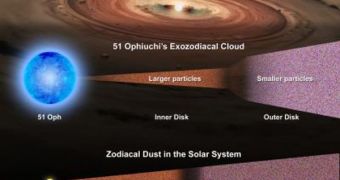The Keck Telescopes are today widely regarded as being among the top observatories in the world, due to their ability to probe deeply within the sky, with great accuracy and detail. Recently, astronomers wielding the twin ten-meter telescopes have analyzed the most compact dust disks ever found around another star, using the Keck Interferometer Nuller (KIN). This instrument combines light from both observatories, using interferometry, and is so sensitive, that objects very far away can be seen around their stars. Normally, their brightness would be surpassed by their stars' glare.
“This is the first compact disk detected by the KIN, and a demonstration of its ability to detect dust clouds a hundred times smaller than a conventional telescope can see,” the leader of the research team, NASA Goddard Space Flight Center astronomer Christopher Stark, explains. The dual object is not small, per se. Rather, if placed inside our own solar system, the inner dust disk would extend over four times the distance between the Earth and the Sun, and would reach the orbit of Jupiter. The outer disk extends hundreds of time farther into space, the team reveals.
Essentially, what KIN does is combine light from the two telescopes in a manner that allows astronomers to artificially create a blind spot in an area of interest. In the case of the newly analyzed formations, their B-type parent star, 51 Ophiuchi, located some 410 light-years away, was completely removed from the picture, and this allowed for the faint glow of objects around it to be resolved. “Our new observations suggest 51 Ophiuchi is a beautiful protoplanetary system with a cloud of dust from comets and asteroids extremely close to its parent star,” Goddard research team member, astronomer Marc Kuchner adds.
“Our study shows that 51 Ophiuchi's disk is more than 100,000 times denser than the zodiacal dust in the solar system. This suggests that the system is still relatively young, with many colliding bodies producing vast amounts of dust,” Stark says. Regularly, in star systems, the area closest to the parent star is filled with dust. Comets disintegrate when they are melted, and asteroids collide frequently. For instance, in the case of our own solar system, most dust is concentrated inwards of Jupiter's orbit. When sunlight hits the dust, it sometimes makes it glow, and this phenomenon is called the zodiacal light.

 14 DAY TRIAL //
14 DAY TRIAL //